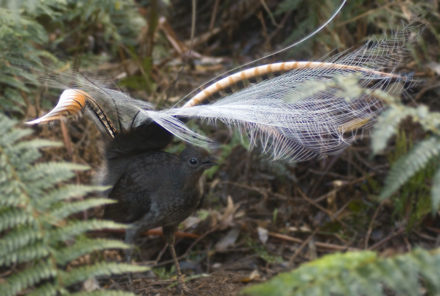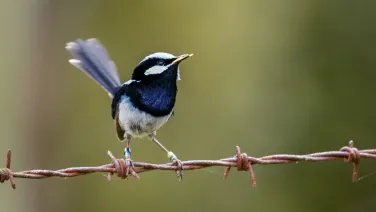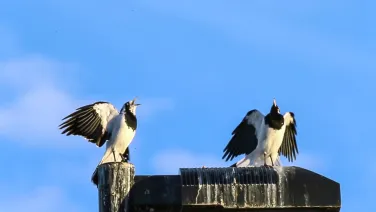
Magrath Group - Behavioural ecology; acoustic communication; ornithology
We have broad interests in behavioural ecology, particularly acoustic communication and breeding biology in birds.
About
We have broad interests in behavioural ecology, particularly acoustic communication and breeding biology in birds. Our current work is focussed on communication about danger, eavesdropping among species, and vocal mimicry. See the 'Wildlife Australia' article below, for a non-technical introduction to our work on alarm calls and eavesdropping in avian communities.
In addition to our current projects, we have worked on duetting, brood division, hatching asynchrony, egg size, life-history and cooperative breeding in birds.
Awards
Publications
Selected publications
- Zhou, Y., Radford, A.N. & Magrath, R.D. 2024. The effect of temporal masking on alarm call communication in wild superb fairy-wrens. Animal Behaviour, in press.
- Camerlenghi, E. Nolazco, S., Farine, D. R., Magrath, R. D. & Peters, A. 2024. Social restructuring during harsh environmental conditions favours cooperative behaviour in a songbird multilevel society. Proceedings of the Royal Society of London, B 291: 20232427.
Zhou, Y., Radford, A.N. & Magrath, R.D. 2024. Mechanisms of noise disruption: masking, not distraction or increased vigilance, compromises wild bird communication. Animal Behaviour, 214: 55-63.
Liao, C-C., Magrath, R.D., Manser, M.B. & Farine, D.R. 2024. The relative contribution of acoustic signals versus movement cues in group coordination and collective decision-making. Philosophical Transactions of the Royal Society, B, 379: 20230184.
Goodale, E. & Magrath, R.D. 2024. Species diversity and interspecific information flow. Biological Reviews, published online 17 Feb 2024.
Zhou, Y., Radford, A.N. & Magrath, R.D. 2024. Noise constrains heterospecific eavesdropping more than conspecific reception of alarm calls. Biology Letters, 20: 20230410.
Liao, C-C., Chen, C-C. & Magrath, R.D. 2024. Asymmetric information in mixed species mobbing flocks: why are leader species species? Animal Behaviour, published online 15 Feb 2024.
Ręk, P. & Magrath, R. D. 2023. The quality of avian duets can be assessed independently of the spatial separation of signallers. Scientific Reports, 13: 16438.
Turner, C. R., Spike, M. & Magrath, R. D. 2023. The evolution of eavesdropping on heterospecific alarm calls: relevance, reliability, and personal information. Ecology & Evolution, 13: e10272. [online 13 July 2023].
Turner, C. R., Mann, S. F., Spike, M., Magrath, R. D., & Sterelny, K. 2023. Joint evolution of traits for social learning. Behavioural Ecology & Sociobiology, 77: 47 [online 21 April 2023].
Camerlenghi, E. Nolazco, S., Farine, D. R., Magrath, R. D. & Peters, A. 2023. Multilevel social structure predicts individual helping responses in a songbird. Current Biology, 33 [online 9 Mar 2023].
Backhouse, F., Welbergen, J., Magrath, R. D. & Dalziell, A.H. 2023. Depleted cultural richness of an avian vocal mimic in fragmented habitat. Diversity & Distributions, 29: 109-122.
Ręk, P. & Magrath, R. D. 2022. Reality and illusion: the assessment of angular separation of multi-modal signallers in a duetting bird. Proceedings of the Royal Society of London, B 289: 20220680.
Ręk, P. & Magrath, R. D. 2022. Display structure size affects the production and response to multi-modal duets in magpie-larks. Animal Behaviour, 187: 137-146.
Dalziell, A. H., Welbergen, J., Magrath, R. D. 2022. Male superb lyrebirds mimic functionally-distinct heterospecific vocalisations during different modes of sexual display. Animal Behaviour, 188: 181-196.
Backhouse, F., Dalziell, A. H., Magrath, R. D., & Welbergen, J. A. 2022. Higher-order sequences of vocal mimicry performed by male Albert’s lyrebirds are socially transmitted and enhance acoustic contrast. Proceedings of the Royal Society of London, B, 289: 20212498. [Accepted 9 Feb 2022.]
- Ratnayake, C. P., Zhou, Y., Dawson Pell, F. S. E., Potvin, D. A., Radford, A. N., Magrath, R. D. 2021. Visual obstruction, but not moderate traffic noise, increases reliance on heterospecific alarm calls. Behavioral Ecology, 32: 941-951.
- Dalziell, A. H., Maisey, A. C., Magrath, R. D., & Welbergen, J. A. 2021 Male lyrebirds create a complex illusion of a mobbing flock during courtship and copulation. Current Biology 31, 1-7.
- Ręk, P. & Magrath, R. D. 2020. Visual displays enhance vocal duet production and the perception of coordination despite spatial separation of partners. Animal Behaviour, 168: 231-241
- Rowell, T.A.A.D., Magrath, M.J.L., & Magrath, R.D. 2020. Predator-awareness training in terrestrial vertebrates: progress, problems and possibilities. Biological Conservation, 252: 108740.McLachlan, J. R. & Magrath, R. D. 2020. Speedy revelations: how alarm calls can convey rapid, reliable information about urgent danger. Proceedings of the Royal Society of London, B, 287: 20192772.
- Tegtman, N. & Magrath, R. 2020 Discriminating between similar alarm calls of contrasting function. Philosophical Transactions of the Royal Society, B, 375: 20190474.
- Zhou, Y., Radford, A.N. & Magrath, R.D. 2019. Why does noise reduce response to alarm calls? Experimental assessment of masking, distraction and greater vigilance in wild birds. Functional Ecology, 33: 1280-1289.
McLachlan, J. R., Ratnayake, C.P., & Magrath, R.D. 2019. Personal information about danger trumps social information from avian alarm calls. Proceedings of the Royal Society of London, B, 286: 20182945.
Magrath, R. D., Haff, T. M. & Igic, B. 2020. Interspecific communication: gaining information from heterospecific alarm calls. In Coding Strategies in Vertebrate Acoustic Communication (Eds. T. Aubin & N. Mathevon). Heidelberg: Springer.
Igic, B., Ratnayake, C.P., Radford, A.N. & Magrath, R.D. 2019. Eavesdropping magpies respond to the number of heterospecifics giving alarm calls but not the number of species calling. Animal Behaviour, 148: 133-143.
Potvin, D.A., Ratnayake, C.P., Radford, A.N. & Magrath, R.D. 2018. Birds learn socially to recognize heterospecific alarm calls by acoustic association. Current Biology, 28: 1-6.
Dawson Pell, F.S.E., Potvin, D.A., Ratnayake, C.P., Fernández-Juricic, E., Magrath, R.D. & Radford, A.N. 2018. Birds orient their heads appropriately in response to functionally referential alarm calls of heterospecifics.Animal Behaviour, 140: 109-118.
Murray, T. G., Zeil, J. & Magrath, R. D. 2017. Modified flight feathers produce sounds that are reliable alarm signals. Current Biology, 27: 1-6.
Ręk, P. & Magrath, R. D. 2017. Deceptive vocal duets and multi-modal display in a songbird. Proceedings of the Royal Society of London, B 284: 20171774.
Butler, N. E., Magrath, R. D. & Peters, R. A. 2017. Lack of alarm calls in a gregarious bird: models and videos of predators prompt alarm responses but no alarm calls by zebra finches. Behavioral Ecology & Sociobiology71: 113.
McQueen, A., Naimo, A. C, Teunissen, N., Magrath, R. D., Delhey, K. & Peters, A. 2017. Bright birds are cautious: seasonally conspicuous plumage prompts risk avoidance in male superb fairy-wrens. Proceedings of the Royal Society of London, B, 284: 20170446.
- Cunningham, S. & R. D. Magrath. 2017. Functionally referential alarm calls in noisy miners communicate about predator behaviour. Animal Behaviour, 129: 171-179.
- Magrath et al. 2017. Neighbourhood watch: alarm calls and eavesdropping in wild bird communities. Wildlife Australia, Autumn 2017, pp. 6-10.
- Ręk, P. & Magrath, R. D. 2016. Multimodal duetting in magpie-larks: how do vocal and visual components contribute to a cooperative signal’s function? Animal Behaviour, 117: 35-42.
- Murray, T. G. & Magrath, R. D. 2015. Does signal deterioration compromise eavesdropping upon other species' alarm calls? Animal Behaviour 108: 33-41.
- Magrath, R. D., Haff, T. M., McLachlan, J. R. & Igic, B. 2015. Learning by wild birds to eavesdrop on heterospecific alarm calls. Current Biology 25: 2047-2050. http:// dx.doi.org/10.1016/j.cub.2015.06.028
- Igic, B., McLachlan, J., Lehtinen, I. & Magrath, R. D. 2015. Crying wolf to a predator: deceptive vocal mimicry by a bird protecting young. Proceedings of the Royal Society of London, B, 282: 20150798.
- Ibáñez-Álamo, J. D., Magrath, R. D., Oteyza, J. C., Chalfoun, A. D., Haff, T. M. Schmidt, K. A., Thomson, R. L. & Martin, T. E. 2015. Nest predation research: recent findings and future perspectives. Journal of Ornithology 156 (Suppl. 1): S247-S262.
- Haff, T. M., Horn, A. G., Leonard, M. L. & R. D. Magrath. 2015. Conspicuous calling near cryptic nests: a review of hypotheses and a field study on white-browed scrubwrens. Journal of Avian Biology, 46: 289-302.
- Dalziell, A. H., Welbergen, J. A., Igic, B. & R. D. Magrath. 2015. Avian vocal mimicry: a unified conceptual framework. Biological Reviews, 90: 643-658.
- Magrath, R. D., Haff, T. M., Fallow, P. M. & Radford, A. N. 2015. Eavesdropping on heterospecific alarm calls: from mechanisms to consequences. Biological Reviews, 90: 560-586.
- Igic, B. & Magrath, R. D. 2014. A songbird mimics different heterospecific alarm calls in response to different types of threat. Behavioral Ecology, 25: 538–548.
- Dalziell, A.H., Peters, R.A., Cockburn, A., Dorland, D.D., Maisey, A.C. & Magrath, R.D. 2013. Dance choreography is coordinated with song repertoire in a complex avian display. Current Biology, 23 (12): 1132-1135
- Haff TM, Magrath RD. 2013. To call or not to call: parents assess the vulnerability of their young before warning them about predators. Biology Letters, 9: 20130745.
- Igic, B. & Magrath, R. D. 2013. Fidelity of vocal mimicry: identification and accuracy of mimicry of heterospecific alarm calls by the brown thornbill. Animal Behaviour, 85: 593-603.
- Fallow, P. M., Pitcher, B. J. & Magrath, R.D. 2013. Alarming features: birds use specific acoustic properties to identify heterospecific alarm calls. Proceedings of the Royal Society of London, B, 280: 20122539.
- Haff, T. M. & Magrath, R. D. 2013. Eavesdropping on the neighbours: fledglings learn to respond to heterospecific alarm. Animal Behaviour, 85: 411-418.
- Haff, T. M. & Magrath, R. D. 2012. Learning to listen? Nestling response to heterospecific alarm calls. Animal Behaviour, 84: 1401-1410
- Dalziell, A. H. & Magrath, R. D. 2012. Fooling the experts: accurate vocal mimicry in the song of the superb lyrebird, Menura novaehollandiae. Animal Behaviour, 83: 1401-1410.
- Magrath, R. D. & Bennett, T. H. 2012. A micro-geography of fear: learning to eavesdrop on alarm calls of neighbouring heterospecifics. Proceedings of the Royal Society of London, B 279: 902-909.
- Haff, T. M. & Magrath, R. D. 2011. Calling at a cost: elevated nestling calling attracts predators to active nests. Biology Letters 7: 493-495.
- Fallow, P. M., Gardner, J. L. & Magrath, R. D. 2011. Sound familiar? Acoustic similarity provokes responses to unfamiliar heterospecific alarm calls. Behavioral Ecology, 22: 401-410.
- Gardner, J. L., Trueman, J. W. H., Ebert, D., Joseph, L. & Magrath, R. D. 2010. Phylogeny and evolution of the Meliphagoidea, the largest radiation of Australasian songbirds. Molecular Phylogenetics and Evolution, 55: 1087-1102.
- Magrath, R. D., Haff, T. M., Horn, A. G., & Leonard, M. L. 2010. Calling in the face of danger: predation risk and acoustic communication by parent birds and their offspring. Advances in the Study Behavior, 41: 187-253.
- Goodale, E., Beauchamp, G. Magrath, R. D., Nieh, J. C. & Ruxton, G. D. 2010. Interspecific information flow influences animal community structure. Trends in Evolution and Ecology, 25: 354-361.
- Haff, T. & Magrath, R. D. 2010. Vulnerable but not helpless: nestlings are fine-tuned to cues of approaching danger. Animal Behaviour, 79: 487-496.
- Fallow, P. M. & Magrath, R. D. 2010. Eavesdropping on other species: mutual interspecific understanding of urgency information in avian alarm calls. Animal Behaviour, 79: 411-417.
- Hingee, M. & Magrath, R. D. 2009. Flights of fear: a mechanical wing whistle sounds the alarm in a flocking bird. Proceedings of the Royal Society of London, B, 276: 4173-4179.
- Magrath, R. D., Pitcher, B. J. & Gardner, J. L. 2009. An avian eavesdropping network: alarm signal reliability and heterospecific response. Behavioral Ecology, 20: 745-752.
- Magrath, R. D., Pitcher, B. J. & Gardner, J. L. 2009. Recognition of other species' aerial alarm calls: speaking the same language or learning another? Proceedings of the Royal Society of London, B: 276, 769-774.
- Magrath, R. D., Pitcher, B. J. & Dalziell, A. H. 2007. How to be fed but not eaten: nestling responses to parental food calls and the sound of a predator's footsteps. Animal Behaviour, 74: 1117-1129.
- Magrath, R. D., Pitcher, B. J. & Gardner, J. L. 2007. A mutual understanding? Interspecific responses by birds to each other's aerial alarm calls. Behavioral Ecology 18: 944-951.
- Hall, M. L. & Magrath, R. D. 2007. Temporal coordination signals coalition quality. Current Biology 17: R406-407.
- Magrath R. D., Platzen D. & Kondo, J. 2006. From nestling calls to fledgling silence: adaptive timing of change in response to aerial alarm calls. Proceedings of the Royal Society of London, B, 273: 2335-2341.
- Platzen D. & Magrath R. D. 2005. Adaptive differences in response to two types of parental alarm calls in altricial nestlings. Proceedings of the Royal Society of London, B 272: 1101-1106.
- Leavesley A & Magrath RD. 2005. Communicating about danger: urgency alarm calling in a bird. Animal Behaviour 70: 365-373.
- Platzen, D. & Magrath, R. D. 2004. Parental alarm calls suppress nestling vocalization. Proceedings of the Royal Society of London, B, 271, 1271-1276.
- Magrath, R. D., Johnstone, R. A. & Heinsohn, R. G. 2004. Reproductive skew. In: Ecology and Evolution of Cooperative Breeding in Birds (Ed. by Koenig, W. D. & Dickinson, J. L.), pp. 157-176. Cambridge: Cambridge University Press.
- Leedman, A. W. & Magrath, R. D. 2003. Long-term brood division and exclusive parental care in a cooperatively breeding passerine. Animal Behaviour, 65, 1093-1108.
- Magrath, R. D. 2001. Group breeding dramatically increases reproductive success of yearling but not older female scrubwrens: a model for cooperatively breeding birds? Journal of Animal Ecology, 70, 370-385.
- Nicholls, J. A., Double, M. C., Rowell, D. M. & Magrath, R. D. 2000. The evolution of cooperative and pair breeding in the thornbills Acanthiza (Aves: Pardalotidae). Journal of Avian Biology, 31, 165-176.
- Krebs, E. A. & Magrath, R. D. 2000. Food allocation in crimson rosella broods: parents differ in their responses to chick hunger. Animal Behaviour, 59, 739-751.
- Hall, M. L. & Magrath, R. D. 2000. Duetting and mate-guarding in Australian magpie-larks (Grallina cyanoleuca). Behavioral Ecology and Sociobiology, 47, 180-187.
- Magrath, R. D. & Whittingham, L. A. 1997. Subordinate males are more likely to help if unrelated to the breeding female in cooperatively-breeding white-browed scrubwrens. Behavioral Ecology and Sociobiology, 41, 185-192.
- Whittingham, L. A., Dunn, P. O. & Magrath, R. D. 1997. Relatedness, polyandry and extra-group paternity in the cooperatively-breeding white-browed scrubwren (Sericornis frontalis). Behavioral Ecology and Sociobiology, 40, 261-70.
- Crick, H. Q. P., Gibbons, D. W. & Magrath, R. D. 1993. Seasonal variation in clutch size in British birds. Journal of Animal Ecology, 62, 263-273.
- Magrath, R. D. 1992. The effect of egg mass on the growth and survival of blackbirds: a field experiment. Journal of Zoology, London, 227, 639-653.
- Magrath, R. D. 1991. Nestling weight and juvenile survival in the blackbird, Turdus merula. Journal of Animal Ecology, 60, 335-351.
- Magrath, R. D. 1990. Hatching asynchrony in altricial birds. Biological Reviews, 65, 587-622.
- Magrath, R. D. 1989. Hatching asynchrony and reproductive success in the blackbird. Nature, 339, 536-538.




